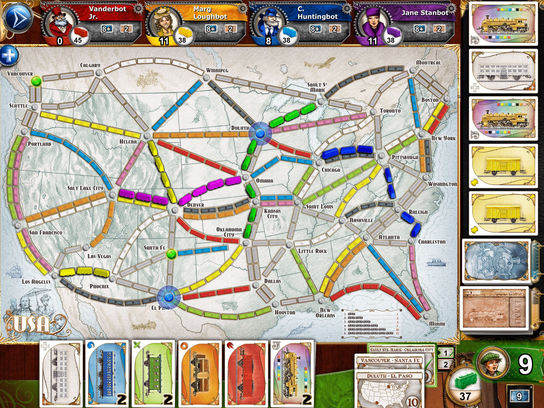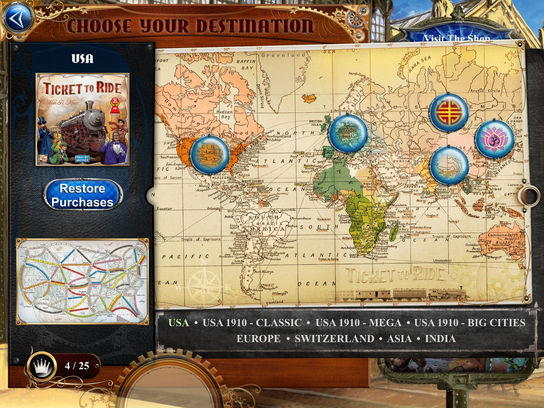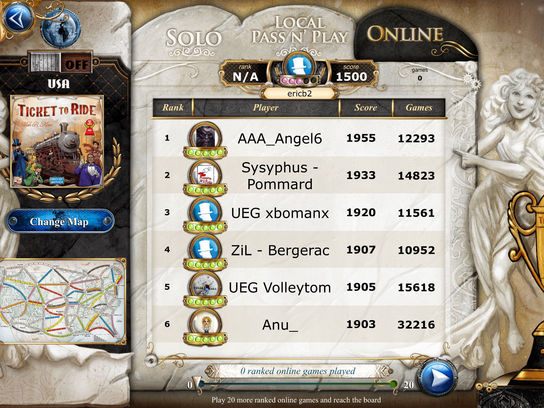
The name Ticket to Ride may not be as well-known as the ubiquitous board game classics like Monopoly or Cluedo, but with nearly 4 million copies sold since it was released in 2004 it’s certainly getting there. A family-friendly title for up to five players it’s essentially a race to claim as many train routes as possible (more exciting than it sounds!) Not only has it won numerous gaming awards but it’s seen as a landmark title in the board game boom of the last decade. As a lapsed tabletop gamer it seems the logical first step for me to re-enter this world.
First impressions are promising as unpacking it from the box reveals a sturdy board, numerous coloured train models, point counters, two packs of cards and just three pages of instructions. There’s no assembly required which is reassuring for a new gamer – you could potentially be playing in under five minutes from opening it up (plus a few minutes to read the instructions). The simplicity of the instructions also means there’s no hassle explaining the rules to someone who has never played before. The only negative observation early on (and it’s a minor one) is that the cards themselves could do with being larger.

The game itself is actually surprisingly straightforward anyway – and requires no actual knowledge of trains! The board portrays a stylized map of North America with several big cities linked by routes of various colours and lengths. Players start with a handful of train car cards and can draw more each turn, aiming to gather enough of one colour to be able to claim a route for themselves. The claiming is done by placing your own train figures on the route (there’s something extremely satisfying about doing so) and points are awarded depending on the length of the route. The game ends when one player has used up all their train figures, with the winner being whoever has the most points (with a bonus awarded to the player with the longest unbroken route).
That’s the core aim of Ticket to Ride anyway, although there is another core aspect to it. All players start with at least two destination tickets, each of which lists two cities, which they keep secret from other players. Successfully linking these two cities unlocks further points but failing to do so results in an equivalent penalty. Players can choose to draw more destination tickets on their turn instead of train cards or claiming routes, and the risk/reward nature of them can result in some dramatic changes in fortune. Particularly as these points are only revealed at the end of the game, unlike the points for claiming routes which are kept track of during gameplay.
Like many of the best games it’s deceptively simple, but with hidden depths. You can choose to claim the easy routes early on for modest points, or save your cards in the hope of claiming the bigger routes – with the constant fear that someone else may swoop in before you and ruin your plans. It was also obvious in my early games that I and another novice focused just on claiming what routes we could, while the more experienced players clearly had more attention on their long-term goals. Another aspect that becomes more prevalent as you play is the tactical blocking of other players, rather than just trying to build your own routes.

Despite all this, Ticket to Ride is at its heart still a fairly simple game and luck does play its part, so younger or more inexperienced players can (and frequently will) be able to complete on an even footing. Games typically last just under an hour, and tend to start flowing more quickly as everyone becomes even more familiar with the rules. Of course given the uncomplicated gameplay I can see that gamers could perhaps become overly familiar with the limited routes and options eventually – although I imagine that it would take a lot of game hours before that became a problem. And even if it did, there are a whole raft of spin-off editions available to keep things fresh.
At this point I should also mention the little touches that show the care that has gone into Ticket to Ride. As well as including some spare train figures (as some will inevitably go missing) all the colour-coded routes and cards also have unique symbols on them – just in case any players have a degree of colour blindness. Slightly amended rules are listed for games of only two or three players while there are also cards summarising the rules which be consulted by players during the game rather than having to refer back to the instructions. These may only be small points, but it really contributes to a feeling of quality.
Overall though Ticket to Ride is a pretty fantastic board game, and it’s not hard to see why it’s so popular and highly thought of. I’ve since become aware that digital versions are available, but I can’t help but feel they wouldn’t be as fun. After all, it’s that colourful board and physical aspect of claiming routes with the train figures that feels so satisfying. I can wholeheartedly recommend it to gamers of any level, and personally it feels like the perfect gateway back into the world of tabletop board games.

Subscribe to our mailing list
Get the latest game reviews, news, features, and more straight to your inbox
Thank you for subscribing to Bonus Stage.
Something went wrong.
-
Gameplay - /10
0/10
-
Graphics - /10
0/10
-
Sound - /10
0/10
-
Replay Value - /10
0/10





